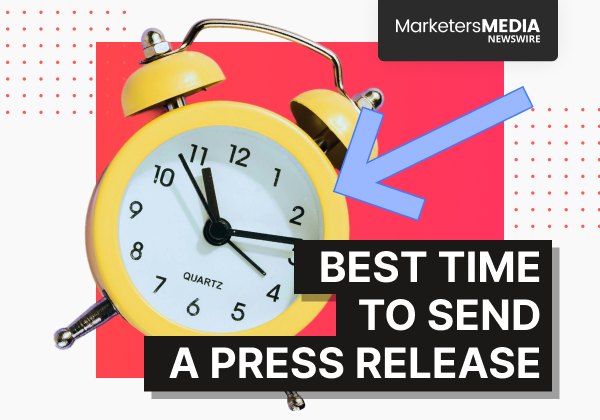Yay, your press release has been published!
It’s now on its way to being distributed in hundreds of media outlets like Business Insider, AP News, and Barchart. (Thanks to services like MarketersMEDIA Newswire.)
Well, what’s next? Don’t sit and wait.
You need to start promoting your press releases—by emailing them to journalists.
Before we go into the details, let's understand the scene.
Journalists are receiving hundreds of press releases and emails from those people in the PR, and they are going to pick just a few noteworthy ones. The rest often ends up just skimmed through or worse, deleted.
That’s why your email pitch to journalists needs to stand out if you are even going to send one. Here’s a list you need to keep in mind when you send out your press release to a journalist or reporter.
What to do before sending your press release
#1 Make sure your press release is written correctly
Your press release needs to be in tip-top shape. That means following the standard press release format and, of course, being error-free. You wouldn't want a typo to be the reason a journalist passes on your story, right?
A well-structured press release typically includes these elements:
- Headline
- Summary
- Date
- Body
- Company Boilerplate
- Contact Information
Each of these components plays a crucial role in conveying your message effectively. If you're not sure about the format or how to structure these elements, check out our blog post on press release templates. It'll give you a solid foundation to work from.
Check for any spelling or grammatical errors, ensure all facts and figures are accurate, and make sure the overall flow of information makes sense.
A clean, well-written press release shows professionalism and increases your chances of catching a journalist's eye.
#2 Make sure your press release is actually newsworthy
This is a big one.
Before you send out your press release, take a step back and ask yourself:
- “Is this really news?”
- “Will the journalist's audience care about this?”
It's easy to get excited about developments in your own company, but you need to look at it from an outsider's perspective. If it doesn't pass the "So what?" test, it might be time to reconsider your angle.
#3 Make sure you identify the right journalists
You can't just blast your press release to every email address you can find. That's a surefire way to end up in the spam folder. Instead, you need to do some detective work.
Use a search engine to find journalists who've written about similar topics or industries. For example, if your press release is about a new productivity app you've developed, look for articles about tech startups, app development, or productivity tools. Make a list of the journalists who've covered these topics and the outlets they write for.
Once you've got your list, dig a little deeper. Read their past work, check out their social media, and get a sense of their interests and the kind of stories they write. This will help you tailor your pitch to each journalist.
Going further, immerse yourself in your industry and become a trusted expert in your niche. Follow relevant newsletters, join online PR communities, and actively participate in conversations. Remember to be genuinely helpful and active in the community, and people will recognize you as a reliable source of information.
As you're making connections and finding useful information, keep track of it all. Build a list of contacts, save relevant articles - you never know when they might come in handy.
By taking these steps, you'll increase your chances of successfully pitching your press release to the right journalists.
How to pitch your press release to journalists
- Write an engaging subject line
- Develop a strong lead for your pitch
- Craft the body of your pitch email
- Include your press release in the email
#1 Write an engaging subject line
Your subject line is literally what stands between your pitch and the journalist’s trash folder, so it needs to pack a punch.
a) Keep it short and sweet
Aim for a maximum of 10 words. Again, journalists are busy people, and they're scanning through dozens, if not hundreds, of emails daily. A concise subject line is more likely to be read in full.
b) Be direct and lead with the most important part
The purpose of the subject line is to inform the recipient what the message is about and, to a certain extent, pique their curiosity and interest. So, if you've got groundbreaking research, a major announcement, or an exclusive scoop, make that clear from the get-go.
c) Use active verbs
They create a sense of immediacy and excitement. For example:
- “Influencer Is The New Brand Ambassador for Sports Company”
What would you feel if you found this email subject line in your inbox? Nothing? Passive sentences like the example above can sound a little dull or neutral.
Now, let's flip it to an active voice:
- “Sports Company Signs Influencer as Brand Ambassador”
Isn't that more exciting?
It's a small change, but it can significantly impact how your email is perceived.
d) Avoid spam trigger words
Some words and phrases can act as red flags for these filters. Avoid using ALL CAPS, excessive punctuation (!!!), or spammy-sounding phrases like "free" or "limited time offer."
Not only can these elements trigger spam filters, but they can also rub journalists the wrong way. Instead of coming across as high priority, using ALL CAPS might read like you're shouting, and it can tick off certain journalists.
e) Make the most of the pre-header text
While not technically part of the subject line, the pre-header text (the text that appears next to or below the subject line in most email clients) is crucial. Use it as a teaser to provide a bit more context and entice the journalist to open your email.
For example, if your subject line is "New Study Reveals Surprising Health Benefits of Coffee," your pre-header could be "3 cups a day could lower risk of heart disease by 25%, says lead researcher."
See how that works together to paint a more complete picture?
#2 Develop a strong lead for your pitch
Once you've nailed the subject line, it's time to focus on the opening of your pitch email.
Start with a personalized introduction that shows you've done your homework. Address the journalist by name and mention why you’ve chosen to reach out to them specifically. Referencing a recent article they've written that relates to your press release topic not only demonstrates your research but also helps create a connection right from the beginning.
Keep it brief—one sentence is enough. Journalists are inundated with emails, so get to the point quickly.
This approach shows that you're not just blasting out a generic email, but have carefully chosen this journalist because their interests align with your news.
Remember, the goal is to pique their interest enough to keep reading. You're not trying to tell the whole story in the lead—just enough to make them want to know more.
#3 Craft the body of your pitch email
Now that you've grabbed the journalist's attention with your engaging subject line and personalized introduction, it's time to dive into the main content of your pitch email. This is where you lay out the key details of your press release, making it clear why your story is newsworthy and worth their time.
Start with the most compelling aspect of your press release. This could be a significant statistic, a bold statement, or a key detail that immediately highlights the importance of your news. For example, if your press release is about groundbreaking research, kick things off with the most surprising finding or a notable quote from a leading expert involved in the project.
Then, provide more context to your news by addressing the 5Ws—what, where, who, why, and when. Keep the pitch 3-4 short paragraphs at most. If you can convey your message in fewer words, even better. This is because journalists often skim through emails quickly, looking for the most critical information.
To add extra value and increase your chances of coverage, consider offering something exclusive. This could be an interview with a key person at your company, additional data not included in the press release, or early access to your product or event. Journalists love exclusives, as they provide unique content for their readers.
#4 Include your press release in the email
Right after you’ve laid out the key points in your pitch, don’t forget to include the full press release.
AND THIS IS IMPORTANT: Instead of attaching your press release as a separate document, paste the full text directly into the email. This way, journalists don’t have to go through the extra step of downloading a file. It increases the likelihood that they will engage with your content right away, which can be especially helpful when they're on tight deadlines.
If you have multimedia files to share, such as images or videos, it's better to include links to these files rather than attaching them. This allows journalists to choose what they want to download, saving space and reducing the chance of your email being flagged by spam filters.
Example of a pitch email
Hi [Journalist’s Name],
I recently read your article on the health impacts of dietary habits, and I thought you might find this new study on coffee consumption interesting. Our latest research shows a significant link between moderate coffee drinking and reduced heart disease risk.
In fact, we found that drinking three cups of coffee a day could lower the risk of heart disease by up to 25%. This study, conducted by our team at [Your Company Name], included over 10,000 participants across multiple demographics.
I'd love to provide more information or arrange an interview with Dr. [Lead Researcher’s Name] to discuss these findings in detail.
I've included the full press release below for your reference.
Best regards,
[Your Name]
[Your Company Name]
[Your Contact Information]
[Press release text]
Extra tips for emailing press releases
#1 Personalize your email
Personalization goes beyond just using the journalist’s name.
Show that you've taken the time to understand their work and their audience. Mentioning their previous articles or specific interests can make your email stand out. Tailor your pitch to align with their focus and style.

#2 Send at the right time
Timing can significantly impact whether your press release gets noticed.
Generally, the best days to send pitch emails are Tuesday, Wednesday, and Thursday, when inboxes are less crowded. Mornings are usually better, but always consider the time zones of the journalists you’re reaching out to. Avoid sending pitches late on Friday or over the weekend, when they’re more likely to be overlooked.
#3 Follow up on your press release
One last note: follow up with your emails, but leave some time before the next email cause nobody likes an obnoxious texter.
Wait a few days to a week before following up, and keep your message brief and to the point. If the journalist hasn't responded after one or two follow-ups, it's best to move on. Remember, persistence is important, but so is respecting the journalist's time and workload.
There you have it; these are the steps and guidelines on how to email a press release to journalists or reporters.
Always remember that sending an email pitch for your press release is more about nurturing the relationship with journalists and reporters. So, take the time to craft thoughtful and personalized pitches, and your efforts will pay off in the long run.
If you’re seeking more ways to enhance your press release, explore our curated list of press release examples to see what works best.
Free Press Release Template
Tell us where to send your PDF:







